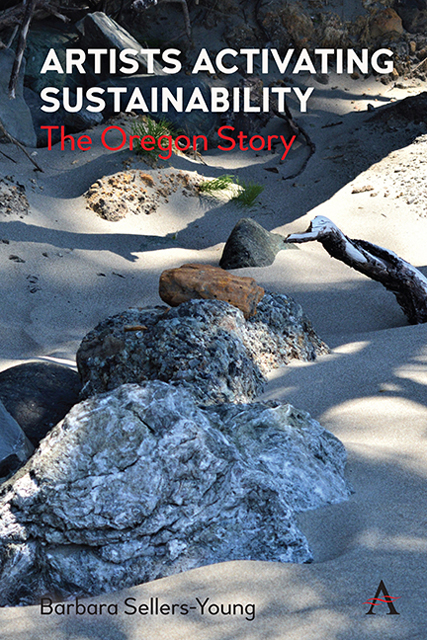Book contents
- Frontmatter
- Dedication
- Contents
- Acknowledgments
- List of Figures
- Introduction: Art, Environment and Metaphor
- 1 Environmental Activism, Arts and the Land of Eden Landscape One: High Desert Basin and Range
- Landscape One High Desert Basin and Range
- Landscape Two Columbia Gorge and Plateau
- Landscape Three Cascade Range
- Landscape Four The Willamette Valley
- Landscape Five Rogue River Valley
- Landscape Six Oregon Coast and Coast Range
- Index
13 - Bandon’s Washed Ashore: Art to Save the Sea
Published online by Cambridge University Press: 10 January 2023
- Frontmatter
- Dedication
- Contents
- Acknowledgments
- List of Figures
- Introduction: Art, Environment and Metaphor
- 1 Environmental Activism, Arts and the Land of Eden Landscape One: High Desert Basin and Range
- Landscape One High Desert Basin and Range
- Landscape Two Columbia Gorge and Plateau
- Landscape Three Cascade Range
- Landscape Four The Willamette Valley
- Landscape Five Rogue River Valley
- Landscape Six Oregon Coast and Coast Range
- Index
Summary
When I get out in the world and I’m giving talks to zoos and aquariums and science centers who are not, who don't think of the arts as their main thing, I get to teach them that you know why this works? Because art is an important language and you have to know how to use it.
Angela Hazeltine PozziAngela Hazeltine Pozzi grew up visiting her grandparents each summer in Bandon or what was called at that time as Bandon by the Sea. Each visit included hours spent wandering the beaches, investigating the many tide pools that existed among the rocks and watching the waves as they pounded the shore. Prior to the mid-nineteenth century, Bandon and its surrounds that Angela walked through had been inhabited by the Coquille people for thousands of years. They established small villages of planked homes along the estuary of the Coquille River and later traded furs with representatives of the Hudson Bay Company. In 1850, gold was discovered at Whiskey Run Creek just north of Bandon and hundreds of gold-seekers left the fields of southern Oregon to look for gold. Eventually, this led to miners attacking the Na-So-Mah village at the mouth of the Coquille River. Hoping to prevent more attacks, the Coquille signed a treaty in 1854 with the United States government. The treaty did not protect them. Instead, the government moved the Coquille north from their native lands to the Siletz reservation that included other Indigenous groups from along Oregon's Coast. An Act of Congress in 1996 gave the Coquille Tribe a reservation area totaling 6,512 acres which is located in numerous non-contiguous parcels in parts of the communities of Bandon, Barview, Coos Bay and North Bend. “In 2015, 3,200 acres of the Coquille people's ancestral homeland in Curry County was restored to the Tribe, through a partnership with Ecotrust Forest Management, an Oregon-based organization working to transform conventional forest management paradigms.”
Bandon: A Brief History
In the latter half of the eighteenth century, settlers from the Willamette Valley moved into the area and established farms some of which began to grow cranberries. In 1873, George Bennett arrived from Bandon, Ireland, and organized a community of 12 voting members to form an election precinct and to adopt the name of Bandon.
- Type
- Chapter
- Information
- Artists Activating SustainabilityThe Oregon Story, pp. 213 - 222Publisher: Anthem PressPrint publication year: 2022



